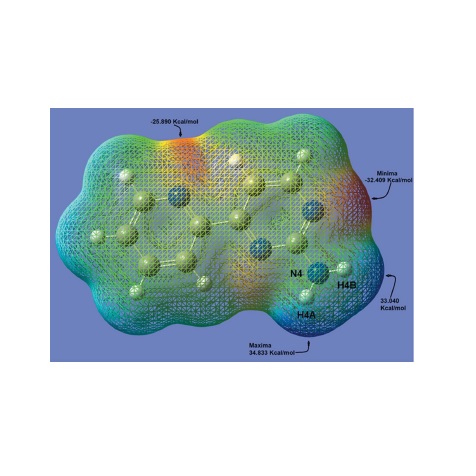Synthesis, spectroscopic (FT-IR and UV-Vis), crystallographic and theoretical studies, and a molecular docking simulation of an imatinib-like template.
MORENO-FUQUEN, Rodolfo; ARANGO-DARAVIÑA, Kevin; GARCIA, Esteban; CLAVIJO, Juan Carlos Tenorio; ELLENA, Javier.
MORENO-FUQUEN, Rodolfo; ARANGO-DARAVIÑA, Kevin; GARCIA, Esteban; CLAVIJO, Juan Carlos Tenorio; ELLENA, Javier.




 Abstract: The aim of the present study was to report the crystal structure and spectroscopic, electronic, supramolecular and electrostatic properties of a new polymorph of 4-(pyridin-2-yl)pyrimidin-2-amine (C9H8N4). The compound was synthesized under microwave irradiation. The single-crystal X-ray structure analysis revealed an angle of 13.36 (8) between the planes of the rings, as well as molecules linked by Nsp2-H N hydrogen bonds forming dimers along the crystal. The material was analyzed by FT-IR vibrational spectroscopy, while a computational approach was used to elucidate the vibrational frequency couplings. The existence of Nsp2-H N hydrogen bonds in the crystal was confirmed spectroscopically by the IR peaks from the N-H stretching vibration shifting to lower wavenumbers in the solid state relative to those in the gas phase. The supramolecular studies confirmed the formation of centrosymmetric R2 2(8) rings, which correspond to the formation of dimers that stack parallel to the b direction. Other weak C-H interactions, essential for crystal growth, were found. The UV-Vis spectroscopic analysis showed a donor-acceptor process, where the amino group acts as a donor and the pyridine and pyrimidine rings act as acceptors. The reactive sites of the molecule were identified and their quantitative values were defined using the electrostatic potential model proposed in the multifunctional wave function analyzer multiwfn. The calculated interaction energies between pairs of molecules were used to visualize the electrostatic terms as the leading factors against the dispersion factors in the crystal-growth process. The docking results showed that the amino group of the pyrimidine moiety was simultaneously anchored by hydrogen-bonding interactions with the Asp427 and His407 protein residues. This compound could be key for the realization of a series of syntheses of molecules that could be used as possible inhibitors of chronic myelogenous leukemia.
Abstract: The aim of the present study was to report the crystal structure and spectroscopic, electronic, supramolecular and electrostatic properties of a new polymorph of 4-(pyridin-2-yl)pyrimidin-2-amine (C9H8N4). The compound was synthesized under microwave irradiation. The single-crystal X-ray structure analysis revealed an angle of 13.36 (8) between the planes of the rings, as well as molecules linked by Nsp2-H N hydrogen bonds forming dimers along the crystal. The material was analyzed by FT-IR vibrational spectroscopy, while a computational approach was used to elucidate the vibrational frequency couplings. The existence of Nsp2-H N hydrogen bonds in the crystal was confirmed spectroscopically by the IR peaks from the N-H stretching vibration shifting to lower wavenumbers in the solid state relative to those in the gas phase. The supramolecular studies confirmed the formation of centrosymmetric R2 2(8) rings, which correspond to the formation of dimers that stack parallel to the b direction. Other weak C-H interactions, essential for crystal growth, were found. The UV-Vis spectroscopic analysis showed a donor-acceptor process, where the amino group acts as a donor and the pyridine and pyrimidine rings act as acceptors. The reactive sites of the molecule were identified and their quantitative values were defined using the electrostatic potential model proposed in the multifunctional wave function analyzer multiwfn. The calculated interaction energies between pairs of molecules were used to visualize the electrostatic terms as the leading factors against the dispersion factors in the crystal-growth process. The docking results showed that the amino group of the pyrimidine moiety was simultaneously anchored by hydrogen-bonding interactions with the Asp427 and His407 protein residues. This compound could be key for the realization of a series of syntheses of molecules that could be used as possible inhibitors of chronic myelogenous leukemia. @article={002981048,author = {MORENO-FUQUEN, Rodolfo; ARANGO-DARAVIÑA, Kevin; GARCIA, Esteban; CLAVIJO, Juan Carlos Tenorio; ELLENA, Javier.},title={Synthesis, spectroscopic (FT-IR and UV-Vis), crystallographic and theoretical studies, and a molecular docking simulation of an imatinib-like template},journal={Acta Crystallographica C},note={v. 75, part 12},year={2019}}
@article={002981048,author = {MORENO-FUQUEN, Rodolfo; ARANGO-DARAVIÑA, Kevin; GARCIA, Esteban; CLAVIJO, Juan Carlos Tenorio; ELLENA, Javier.},title={Synthesis, spectroscopic (FT-IR and UV-Vis), crystallographic and theoretical studies, and a molecular docking simulation of an imatinib-like template},journal={Acta Crystallographica C},note={v. 75, part 12},year={2019}}